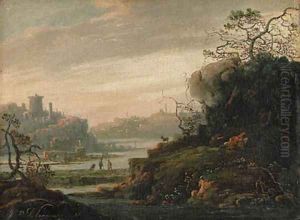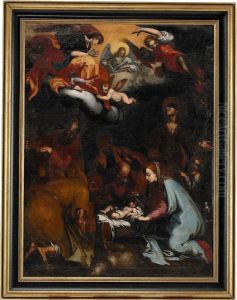Adriaen Bloemaert Paintings
Adriaen Bloemaert was born in Utrecht, the Netherlands, in 1609, into a family deeply embedded in the art world. His father, Abraham Bloemaert, was a well-known Dutch painter and engraver, a prominent figure in the Dutch Golden Age of painting. This background provided Adriaen with an environment rich in artistic influence and training from a young age. He was one of several children, many of whom also pursued artistic careers, thereby continuing the family tradition.
Adriaen's early life was marked by his apprenticeship under his father, from whom he learned the fundamentals of painting and engraving. The influence of his father's style and technique is evident in Adriaen's work, which often mirrors the characteristic elements of the Dutch Golden Age, including attention to detail, a rich palette, and complex compositions. However, Adriaen managed to carve out his own artistic identity, distinguishing his work with personal touches and themes.
Throughout his career, Adriaen Bloemaert worked mainly as an engraver, contributing to the world of printmaking in the Netherlands. He specialized in creating engravings after his father’s designs, as well as after the works of other contemporary artists. His engravings served not only as works of art but also as a means of disseminating the styles and ideas of the Dutch Golden Age to a broader audience. This was a time when printmaking was an essential aspect of artistic production and consumption, making Adriaen's contributions particularly valuable.
Adriaen Bloemaert’s body of work includes a variety of subjects, from religious and mythological scenes to landscapes and genre scenes. His ability to capture detail and emotion in his engravings made him a respected figure among his contemporaries. Despite the prominence of his father, Adriaen succeeded in establishing a reputation in his own right, a testament to his skill and creativity as an engraver.
He lived during a period of significant political, social, and cultural changes in the Netherlands, which influenced the art of the time. The Dutch Republic was experiencing its Golden Age, a period of great wealth, cultural achievement, and artistic flourishing. Adriaen's contributions to the art world were part of this broader context of innovation and excellence in the arts.
Adriaen Bloemaert passed away in 1666, leaving behind a legacy that, while perhaps not as widely recognized as that of his father, significantly contributed to the richness of Dutch Golden Age art. His works continue to be studied and appreciated for their craftsmanship and artistic value, offering insight into the era's visual culture and the Bloemaert family's artistic dynasty.












